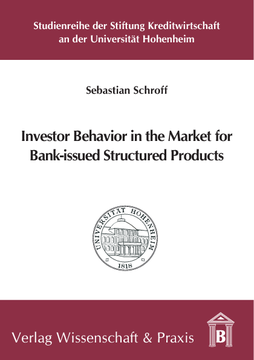Investor Behavior in the Market for Bank-issued Structured Products

BOOK
Cite BOOK
Style
Format
Investor Behavior in the Market for Bank-issued Structured Products
Studienreihe der Stiftung Kreditwirtschaft an der Universität Hohenheim, Vol. 51
(2015)
Additional Information
Book Details
Pricing
Abstract
This work investigates the trading behavior of retail investors in the largest European market place for bank-issued structured products - the European Warrant Exchange (EUWAX). Structured products are designed to grant retail investors access to a broad range of risk-return combinations, ranging from conservative investment products to high-risk leverage products. The focus of the analysis is on the question, how retail investors react to new information and which sources are taken into account when speculating and investing.The key finding is that retail investors actively trade on information, but their trading behavior exhibits various behavioral biases and irrational trading patterns such as herding, overconfidence as well as excessive optimism and risk-taking.In sum, the informational efficiency of retail investor trading in structured products is limited, which underscores the demand for increased efforts by policy makers and financial institutions to improve the financial literacy of retail investors.
Table of Contents
| Section Title | Page | Action | Price |
|---|---|---|---|
| Contents | 5 | ||
| List of Figures | 9 | ||
| List of Tables | 11 | ||
| List of Abbreviations | 13 | ||
| Chapter 1: Introduction | 15 | ||
| 1.1 Motivation | 15 | ||
| 1.2 Research Outline | 17 | ||
| 1.3 Structure of the Thesis | 20 | ||
| Chapter 2: Retail Investor Behavior | 23 | ||
| 2.1 Noise Traders and Market Efficiency | 23 | ||
| 2.2 Trading Motives | 26 | ||
| 2.3 Investor Psychology | 31 | ||
| 2.4 Welfare Evaluation | 38 | ||
| 2.5 Do Retail Investors Move Markets? | 41 | ||
| Chapter 3: The Market for Bank-Issued Structured Products | 47 | ||
| 3.1 Market Design | 48 | ||
| 3.2 Product Design | 52 | ||
| 3.3 Pricing and Complexity | 55 | ||
| Chapter 4: Data & Methodology | 59 | ||
| 4.1 Retail Investor Trading | 59 | ||
| 4.2 Financial Market Information | 64 | ||
| 4.3 Methodological Approach | 66 | ||
| Chapter 5: Retail Investor Information Demand | 69 | ||
| 5.1 Introduction | 69 | ||
| 5.2 Literature Review | 72 | ||
| 5.3 Data | 74 | ||
| 5.3.1 Information Demand and Information Supply | 74 | ||
| 5.3.2 Retail Investor Trading and Market Data | 77 | ||
| 5.4 Empirical Results | 81 | ||
| 5.4.1 Time Series Properties of Information Demand and Supply | 81 | ||
| 5.4.2 Correlation and Causality | 86 | ||
| 5.4.3 Trading Activity | 89 | ||
| 5.4.4 Order Submission Strategies | 92 | ||
| 5.4.5 Positioning | 95 | ||
| 5.4.6 Return Predictability | 98 | ||
| 5.5 Conclusion | 99 | ||
| Chapter 6: Media Sentiment and Leveraged Trading | 103 | ||
| 6.1 Introduction | 103 | ||
| 6.2 Literature Review | 105 | ||
| 6.3 Data | 107 | ||
| 6.3.1 News Data | 107 | ||
| 6.3.2 Trading Data | 113 | ||
| 6.4 Empirical Results | 114 | ||
| 6.4.1 Trading Intensity around News | 114 | ||
| 6.4.2 Order Submission Strategies around News | 123 | ||
| 6.5 Conclusion | 127 | ||
| Chapter 7: Leveraged Trading and Earnings Announcements | 129 | ||
| 7.1 Introduction | 129 | ||
| 7.2 Data | 132 | ||
| 7.2.1 Trading Data | 132 | ||
| 7.2.2 Earnings Surprise and Abnormal Returns | 133 | ||
| 7.3 Methodology | 135 | ||
| 7.3.1 Risk Appetite | 135 | ||
| 7.3.2 Positioning | 138 | ||
| 7.4 Empirical Results | 139 | ||
| 7.4.1 Trading Activity | 139 | ||
| 7.4.2 Correlated Trading | 142 | ||
| 7.4.3 Risk Appetite | 145 | ||
| 7.4.4 Positioning | 152 | ||
| 7.4.5 Predictive Capabilities | 156 | ||
| 7.4.6 Post-event Trading | 158 | ||
| 7.5 Conclusion | 161 | ||
| Chapter 8: Conclusion | 163 | ||
| 8.1 Summary | 163 | ||
| 8.2 Discussion | 164 | ||
| 8.3 Outlook | 166 | ||
| Bibliography | 169 |
